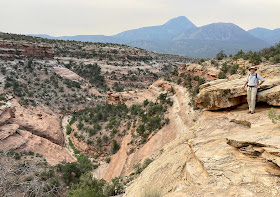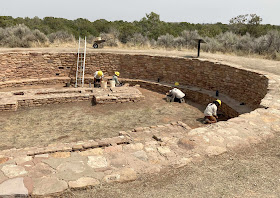Sometimes we are up early to beat the crowds, or to get a parking place at a crowded trail head. But this morning we are up early to beat the heat. Now that we are at a lower elevation, we see temperatures forecast for the 90s today. After our very cool summer, that sounds stifling to us! We had already made the thirty minute drive to the trail head of the Sand Canyon Trail, and the sun wasn't yet up. The first picture of the day is in front of the Sand Castle rock formation, still in the shadows of the rising sun this early morning.
When it did rise, the sun was an eerie florescent orange ball in these smoky skies. It looks like the smoke from the forest fires in northwest Colorado has drifted down to this southwest corner of the state.
It was fun to catch that florescent ball behind some of the plants in this dry desert landscape.
It was unusual lighting as we started the Sand Canyon hike through some of the strange-shaped rock formations that this canyon is known for.
It certainly added another dimension to our walk in the canyon. But we are glad to report that we were amazingly cool this morning.
These neat rock formations have brought people to enjoy this canyon for centuries. In fact, some made their homes here in the protection of these rock alcoves.
The hiking trail has arrows that point to many of the Pueblo Indian ruins, and we took all of those extra trail spurs to see them.
Hikers aren't allowed to enter into the dwellings, so we kept our distance.
Beside those dwellings can be tall cliffs with holes and markings that look like melting ice cream dripping down their face. We can imagine young Puebloan children playing in the holes in the side of this cliff.
We know that the little boy in our group enjoyed climbing into those holes.
This 8.3-mile round trip trail took us to the edge of the deeper canyon that runs through this desert.
On our way back to the car, we took more pictures of the unique qualities of this desert-scape. Our flower picture of the day is different from all the mountain wildflowers Denisa has been photographing this summer.
Likewise, these rocks are different than those we've been hiking around in the mountains. It's yet another type of God's wonders that we get to wander through.
Mark lovingly calls the base of these rock formations, "caramel bubble loaf rocks." That's one of his favorite deserts, so he has good taste in rock formations.
After touring the entire Sand Canyon and all the Indian ruins, Denisa has picked her favorite neighborhood. If they were building a new cliff dwelling 800 years ago, she and Mark would have built here.
This group of rocks looks like something that Dr. Seuss would have drawn, and the Pueblo Indians lived here 800 years before Dr. Seuss was writing books.
We were the only car in the Hovenweep National Monument parking lot for a little while. No rangers are on duty here during the Covid closures, but the 2-mile loop trail is open to get a close-up view of the ruins. One of the most famous are the Twin Towers.
These are not to be confused with the New York City Twin Towers. It's not known why this ancient group built upwards into towers, but these two twins are so big they barely fit into one photo.
The other most famous structure is the Hovenweep Castle, that is perched on the canyon rim and continues with more towers down inside the canyon.
We can get a close-up of the rock construction used by these building engineers 800 years ago.
The afternoon is warming up, and Denisa has changed from her long sleeve blouse worn for the cool morning, to a short-sleeve one. We are not used to this kind of heat, and Denisa doesn't like it! We hiked around this hot area looking for the hand-shaped pictographs that give this site its name, but never found them.
We were needing some air-conditioning by the time we hiked back to the car! Then it was another 30 mile drive to another stop at Lowry Pueblo.
Most of this site is preserved under a roof, but visitors can still walk inside the other parts of this large Indian ruin. As we can see from the picture, Denisa has now zipped off the legs of her hiking pants and traded her boots for sandals. We better get her home and cooled off before she takes off too many layers of clothing!
To provide for insulation from the summer heat and winter cold, the ancients used thick wall construction techniques. Most of the walls employed three layers of rock to make the walls around three feet thick.
The site also included a giant kiva. After 800 years in the desert, these walls need some refurbishment. Like many of the ruins we have seen in our tour of the Canyons of the Ancients, these walls have been rebuilt and upgraded by teams of workers.
The ranger explained that they were working today to shore up the mortar between bricks. It looks like a hot job in full summer sun.
Normally, the first stop on this loop tour would be at the visitor center and museum just outside the town of Dolores. But it is closed because of Covid, so it was our last stop. In fact, we waited to go until sunset because it is just a few miles from our campground. Even though the museum is closed, the half-mile hike will take visitors to the top of the mesa to see the pueblo ruins there.
From the top we can look over Lake McPhee where we were kayaking earlier.
This is Ute Indian country, and the legend of the Sleeping Ute is told to their children. A sign on our hike to the top explained the legend and provided a sketch of the Sleeping Ute.
From our view along the trail, we can see that mountain range to view the outline of the Sleeping Ute during the sunset.
It was a long hot day in the Canyons of the Ancients National Monument today. We hiked 11.7 miles, drove 127 miles, and saw more Indian ruins than we can count. To top it all off, we enjoyed a smoky sunset at the end of another great day of wandering God's wonders.






































No comments:
Post a Comment